TI Stellaris LM3S9D96 32位MCU开发方案
发布时间:2011-8-1 11:19
发布者:Liming
|
TI 公司的Stellaris LM3S9D96是基于ARM® Cortex™-M3的 32位MCU,工作频率80MHz,100DMIPS性能,具有ARM Cortex SysTick定时器和嵌套的向量中断控制器(NVIC)。片内的512KB单周期闪存高达50MHz,96KB单周期SRAM,主要用在运动控制,工业自动化,医疗,交通,电器和风细雨安全接入等。本文介绍了LM3S9D96主要特性,方框图和CPU框图,以及LM3S9D96开发板主要特性,方框图,电路图和元件布局图。 Texas Instruments is the industry leader in bringing 32-bit capabilities and the full benefits of ARM® Cortex™-M3-based microcontrollers to the broadest reach of the microcontroller market. For current users of 8- and 16-bit MCUs, Stellaris with Cortex-M3 offers a direct path to the strongest ecosystem of development tools, software and knowledge in the industry. Designers who migrate to Stellaris benefit from great tools, small code footprint and outstanding performance. Even more important, designers can enter the ARM ecosystem with full confidence in a compatible roadmap from $1 to 1 GHz. For users of current 32-bit MCUs, the Stellaris family offers the industry’s first implementation of Cortex-M3 and the Thumb-2 instruction set. With blazingly-fast responsiveness, Thumb-2 technology combines both 16-bit and 32-bit instructions to deliver the best balance of code density and performance. Thumb-2 uses 26 percent less memory than pure 32-bit code to reduce system cost while delivering 25 percent better performance. The Texas Instruments Stellaris family of microcontrollers—the first ARM Cortex-M3 based controllers—brings high-performance 32-bit computing to cost-sensitive embedded microcontroller applications. These pioneering parts deliver customers 32-bit performance at a cost equivalent to legacy 8- and 16-bit devices, all in a package with a small footprint. LM3S9D96主要特性: The LM3S9D96 microcontroller has the following features: ■ ARM Cortex-M3 Processor Core – 80-MHz operation; 100 DMIPS performance – ARM Cortex SysTick Timer – Nested Vectored Interrupt Controller (NVIC) ■ On-Chip Memory – 512 KB single-cycle Flash memory up to 50 MHz; a prefetch buffer improves performance above 50 MHz – 96 KB single-cycle SRAM – Internal ROM loaded with StellarisWare software: • Stellaris Peripheral Driver Library • Stellaris Boot Loader • SafeRTOS™ kernel • Advanced Encryption Standard (AES) cryptography tables • Cyclic Redundancy Check (CRC) error detection functionality ■ External Peripheral Interface (EPI) – 8/16/32-bit dedicated parallel bus for external peripherals – Supports SDRAM, SRAM/Flash memory, FPGAs, CPLDs ■ Advanced Serial Integration – 10/100 Ethernet MAC and PHY with IEEE 1588 PTP hardware support – Two CAN 2.0 A/B controllers – USB 2.0 OTG/Host/Device – Three UARTs with IrDA and ISO 7816 support (one UART with modem flow control and status) – Two I2C modules – Two Synchronous Serial Interface modules (SSI) – Integrated Interchip Sound (I2S) module ■ System Integration – Direct Memory Access Controller (DMA) – System control and clocks including on-chip precision 16-MHz oscillator – Four 32-bit timers (up to eight 16-bit), with real-time clock capability – Eight Capture Compare PWM pins (CCP) – Two Watchdog Timers • One timer runs off the main oscillator • One timer runs off the precision internal oscillator – Up to 65 GPIOs, depending on configuration • Highly flexible pin muxing allows use as GPIO or one of several peripheral functions • Independently configurable to 2, 4 or 8 mA drive capability • Up to 4 GPIOs can have 18 mA drive capability ■ Advanced Motion Control – Eight advanced PWM outputs for motion and energy applications – Four fault inputs to promote low-latency shutdown – Two Quadrature Encoder Inputs (QEI) ■ Analog Two 12-bit Analog-to-Digital Converters (ADC) with 16 analog input channels and a sample rate of one million samples/second – Three analog comparators – 16 digital comparators – On-chip voltage regulator ■ JTAG and ARM Serial Wire Debug (SWD) ■ 100-pin LQFP package ■ 108-ball BGA package ■ Industrial (-40°C to 85°C) Temperature Range Processor Core (see page 70) All members of the Stellaris product family, including the LM3S9D96 microcontroller, are designed around an ARM Cortex-M3 processor core. The ARM Cortex-M3 processor provides the core for a high-performance, low-cost platform that meets the needs of minimal memory implementation, reduced pin count, and low power consumption, while delivering outstanding computational performance and exceptional system response to interrupts. ■ 32-bit ARM Cortex-M3 architecture optimized for small-footprint embedded applications ■ Outstanding processing performance combined with fast interrupt handling ■ Thumb-2 mixed 16-/32-bit instruction set delivers the high performance expected of a 32-bit ARM core in a compact memory size usually associated with 8- and 16-bit devices, typically in the range of a few kilobytes of memory for microcontroller-class applications – Single-cycle multiply instruction and hardware divide – Atomic bit manipulation (bit-banding), delivering maximum memory utilization and streamlined peripheral control – Unaligned data access, enabling data to be efficiently packed into memory ■ Fast code execution permits slower processor clock or increases sleep mode time ■ Harvard architecture characterized by separate buses for instruction and data ■ Efficient processor core, system and memories ■ Hardware division and fast multiplier ■ Deterministic, high-performance interrupt handling for time-critical applications ■ Memory protection unit (MPU) to provide a privileged mode for protected operating system functionality ■ Enhanced system debug with extensive breakpoint and trace capabilities ■ Serial Wire Debug and Serial Wire Trace reduce the number of pins required for debugging and tracing ■ Migration from the ARM7 processor family for better performance and power efficiency ■ Optimized for single-cycle Flash memory usage ■ Ultra-low power consumption with integrated sleep modes ■ 80-MHz operation ■ 1.25 DMIPS/MHz 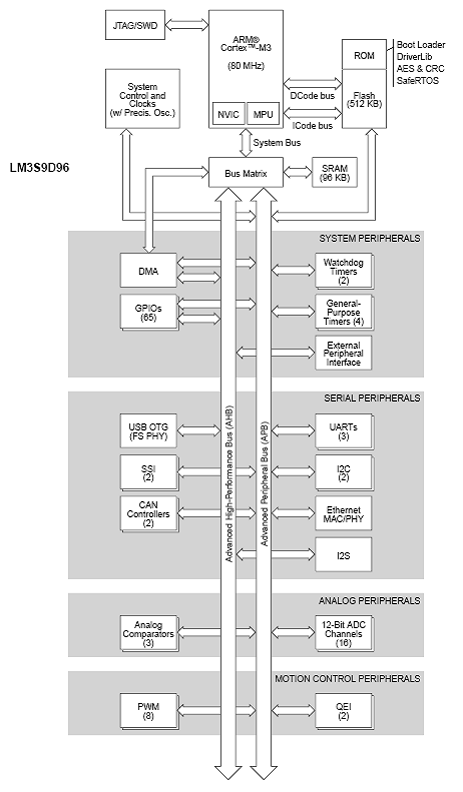
图1。LM3S9D96 MCU方框图 
图2。LM3S9D96 CPU方框图 Stellaris® LM3S9D96开发板 The Stellaris® LM3S9D96 Development Board provides a platform for developing systems around the advanced capabilities of the LM3S9D96 ARM® Cortex™-M3-based microcontroller. The LM3S9D96 is a member of the Stellaris Firestorm-class microcontroller family. Firestorm-class devices include capabilities such as 80 MHz clock speeds, an External Peripheral Interface (EPI) and Audio I2S interfaces. In addition to new hardware to support these features, the DK-LM3S9D96 board includes a rich set of peripherals found on other Stellaris boards. The development board includes an on-board in-circuit debug interface (ICDI) that supports both JTAG and SWD debugging. A standard ARM 20-pin debug header supports an array of debugging solutions. The Stellaris® LM3S9D96 Development Kit accelerates development of Firestorm-class microcontrollers. The kit also includes extensive example applications and complete source code. LM3S9D96开发板主要特性: The Stellaris® LM3S9D96 Development Board includes the following features. Simple set-up—USB cable provides debugging, communication, and power Flexible development platform with a wide range of peripherals Color LCD graphics display – TFT LCD module with 320 x 240 resolution – Resistive touch interface 80 MHz LM3S9D96 microcontroller with 512 K Flash, 96 K SRAM, and integrated Ethernet MAC+PHY, USB OTG, and CAN communications – – 8 MB SDRAM (plug-in EPI option board) – – EPI break-out board (plug-in option board) 1 MB serial Flash memory Precision 3.00 V voltage reference SAFERTOS™ operating system in microcontroller ROM I2S stereo audio codec Line In/Out – Headphone Out – Microphone In Controller Area Network (CAN) Interface 10/100 BaseT Ethernet USB On-The-Go (OTG) Connector – Device, Host, and OTG modes User LED and push button Thumbwheel potentiometer (can be used for menu navigation) MicroSD card slot Supports a range of debugging options – Integrated In-circuit Debug Interface (ICDI)JTAG, SWD, and SWO all supported – Standard ARM® 20-pin JTAG debug connector USB Virtual COM Port Jumper shunts to conveniently reallocate I/O resources Develop using tools supporting Keil™ RealView® Microcontroller Development Kit (MDK-ARM), IAR Embedded Workbench, Sourcery CodeBench development tools, Code Red Technologies development tools, or Texas Instruments’ Code Composer Studio™ IDE Supported by StellarisWare® software including the graphics library, the USB library,and the peripheral driver library Optional expansion boards that work with the External Peripheral Interface (EPI) of the DK-LM3S9D96 development board extend the capabilities of this development platform – Stellaris® Flash and SRAM Memory Expansion Board (DK-LM3S9B96-FS8) • Provides Flash memory, SRAM, and an improved performance LCD interface For more information on the DK-LM3S9B96-FS8 memory expansion board. – Stellaris® FPGA Expansion Board (DK-LM3S9B96-FPGA) (sold separately) • Provides machine-to-machine (M2M), high-bandwidth, parallel interface capability of the Stellaris microcontroller • Allows users to control and display the FPGA expansion board’s video on the DK-LM3S9D96 development board’s large, 3.5” touchscreen display For more information on the DK-LM3S9B96-FPGA expansion board . – Stellaris® EM2 Expansion Board (DK-LM3S9B96-EM2) (sold separately) • Provides a transition between the Stellaris External Peripheral Interface (EPI) connector and the RF Evaluation Module (EM) connector • Enables wireless application development using Low Power RF and RF ID evaluation modules on the Stellaris DK-LM3S9D96 platform 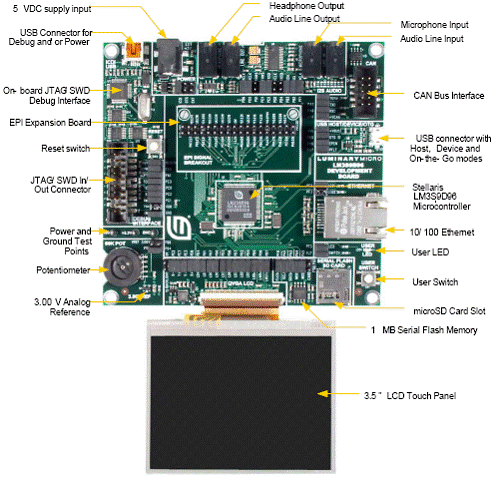
图3。DK-LM3S9D96开发板外形图 LM3S9D96开发板包括: The Stellaris® LM3S9D96 Development Kit contains everything needed to develop and run a range of applications using Stellaris microcontrollers: DK-LM3S9D96 development board 8 MB SDRAM expansion board EPI signal breakout board Retractable Ethernet cable USB Mini-B cable for debugger use USB Micro-B cable for OTG-to-PC connection USB Micro-A to USB A adapter for USB Host USB Flash memory stick microSD Card 20-position ribbon cable CD containing: – A supported version of one of the following (including a toolchain-specific Quickstart guide): • Keil™ RealView® Microcontroller Development Kit (MDK-ARM) • IAR Embedded Workbench • Sourcery CodeBench development tools • Code Red Technologies development tools • Texas Instruments’ Code Composer Studio™ IDE Complete documentation Quickstart application source code – Stellaris® Firmware Development Package with example source code 
图4。DK-LM3S9D96开发板方框图 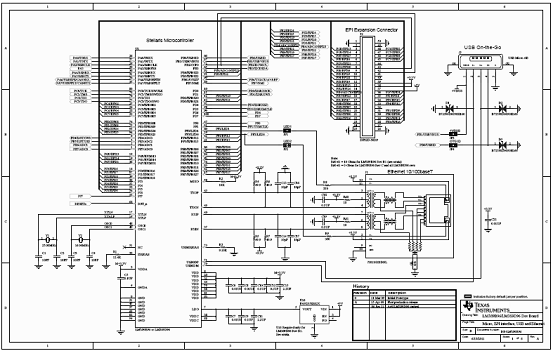
图5。LM3S9D96开发板电路图(1) 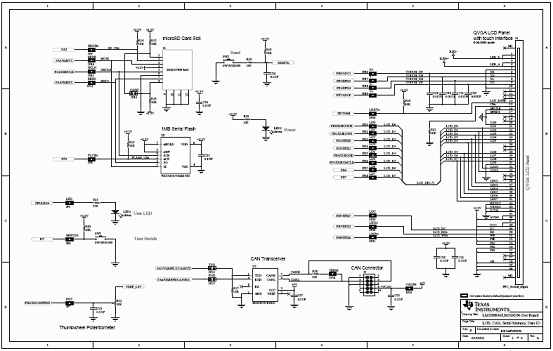
图6。LM3S9D96开发板电路图(2) 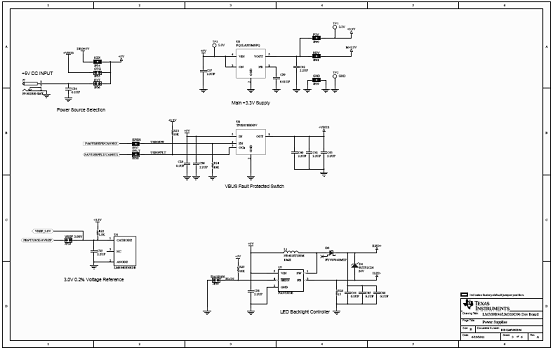
图7。LM3S9D96开发板电路图(3) 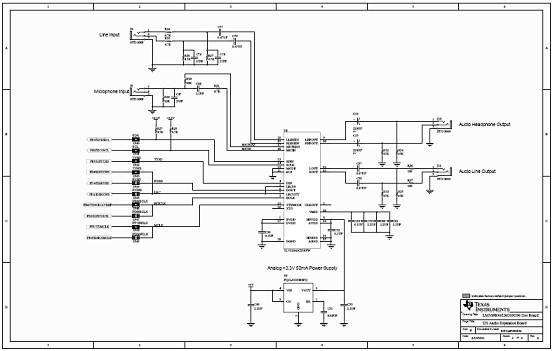
图8。LM3S9D96开发板电路图(4) 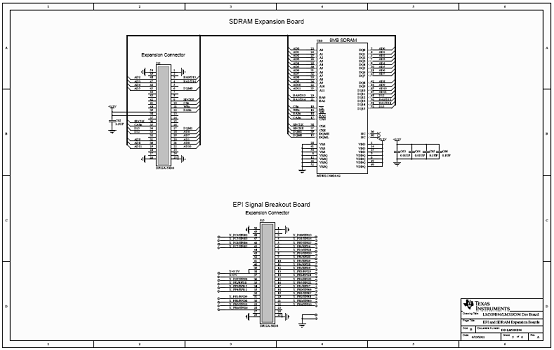
图9。LM3S9D96开发板电路图(5) 
图10。LM3S9D96开发板电路图(6) 
图11。LM3S9D96开发板元件布局图 详情请见: http://focus.ti.com/lit/ds/spms231/spms231.pdf 和 http://focus.ti.com/lit/ug/spmu175/spmu175.pdf |







网友评论